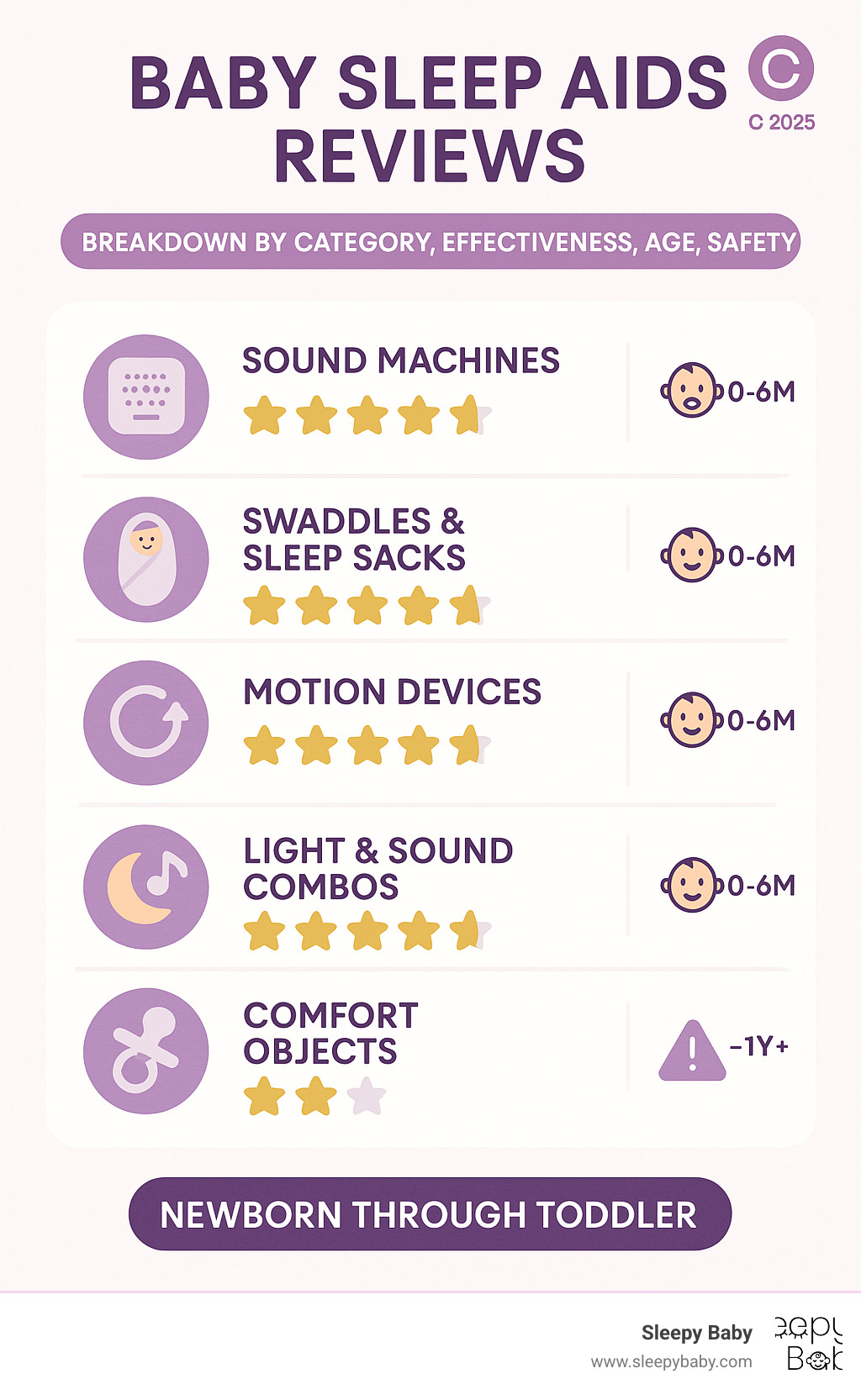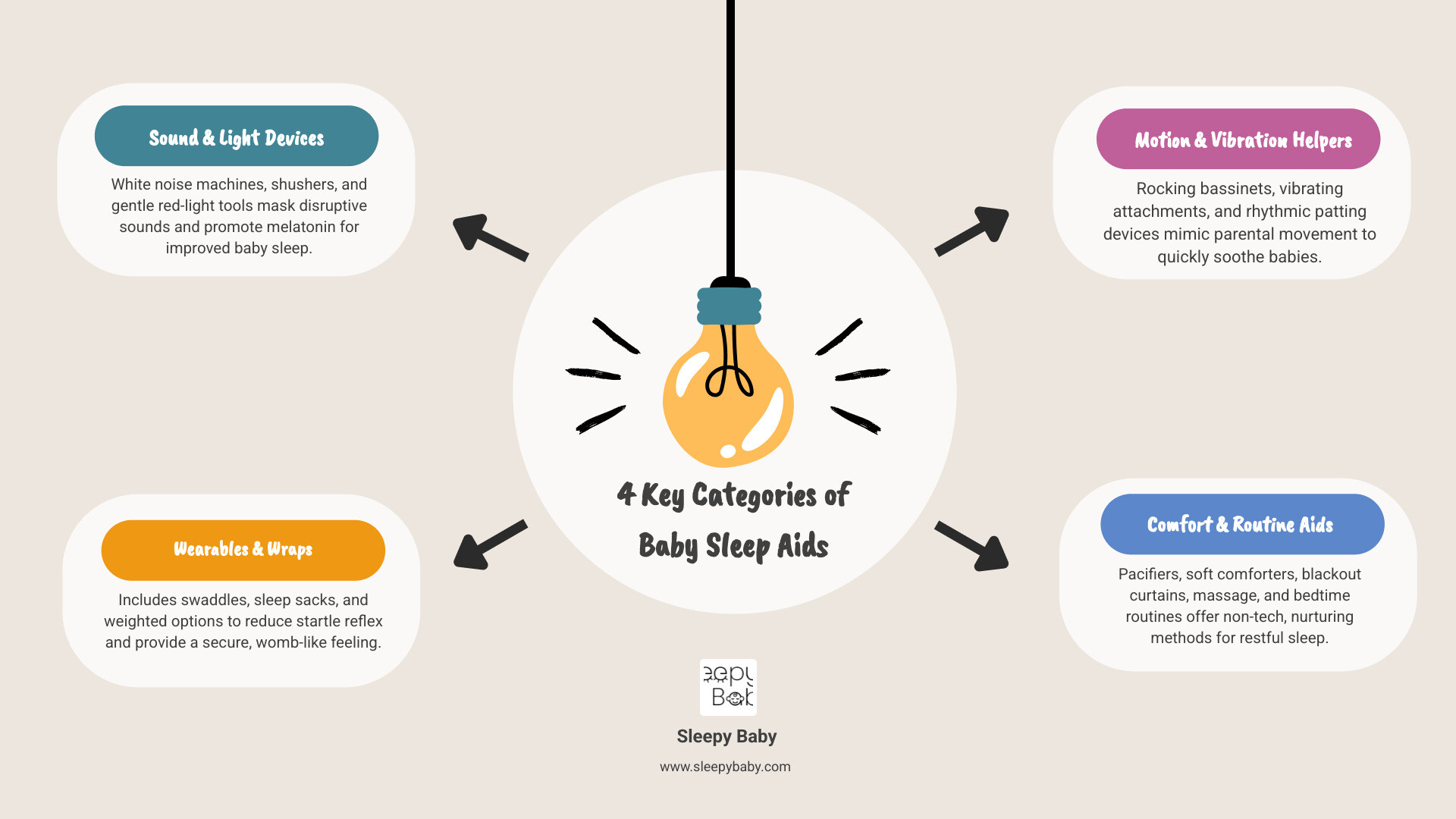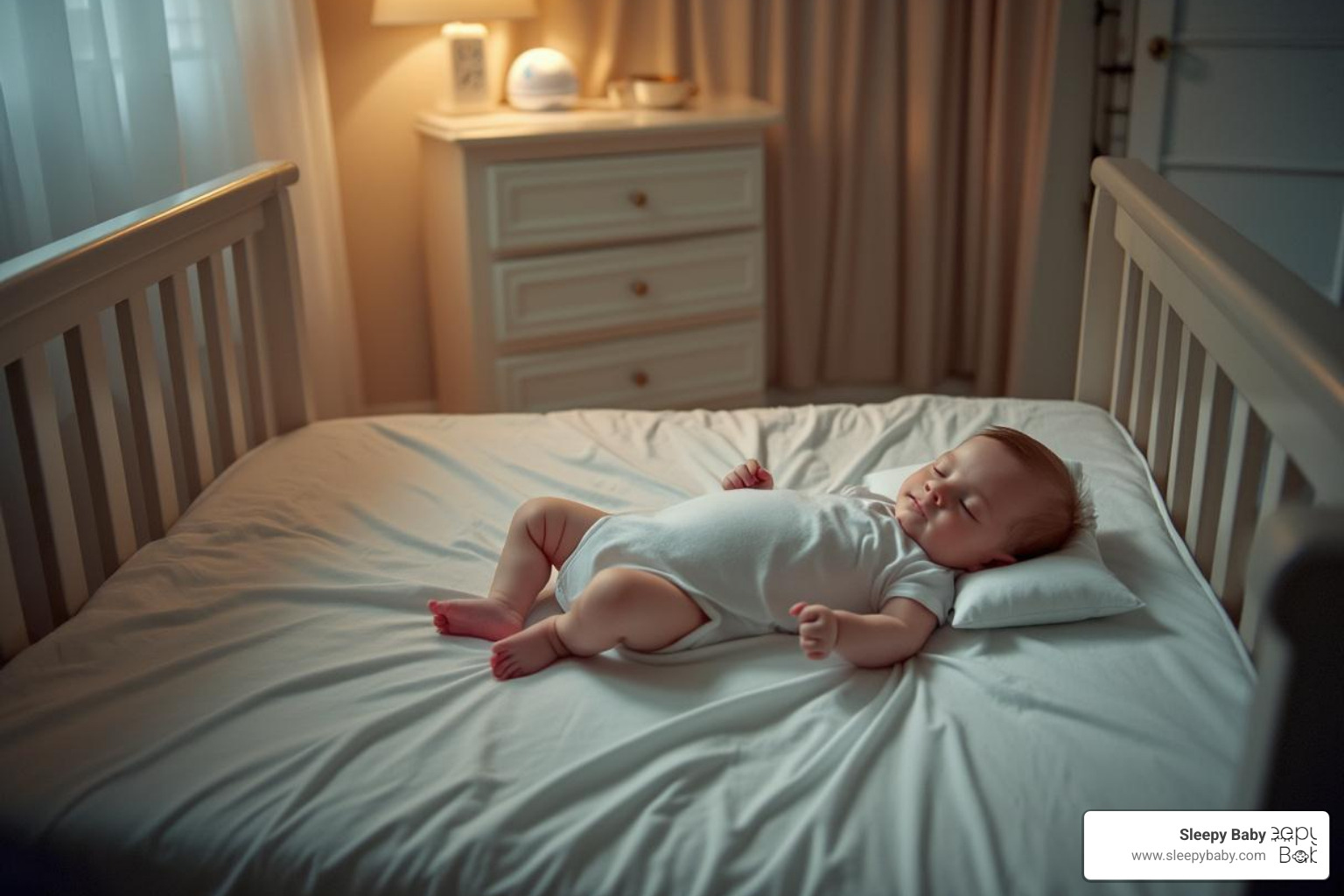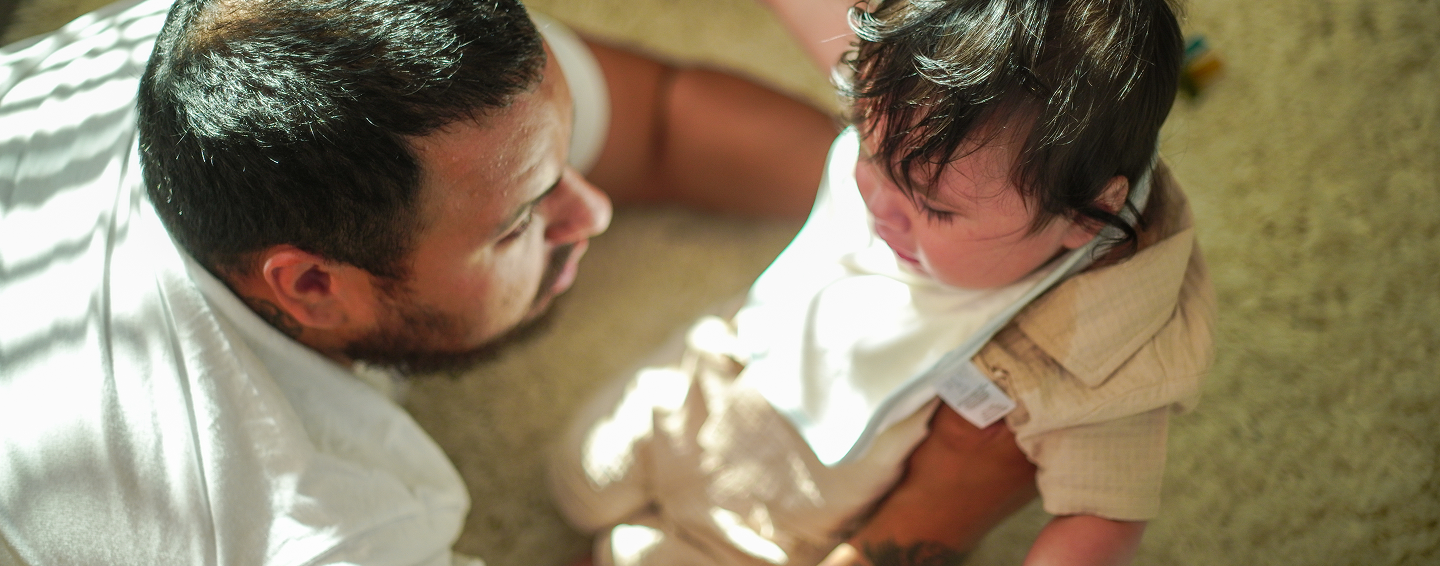Why Finding the Right Baby Sleep Aid Can Transform Your Family's Nights
Baby sleep aid reviews reveal a stark reality: new parents get just 4 hours and 44 minutes of sleep per night during their baby's first year - that's 59% less than the recommended 8 hours. But here's the good news: the right sleep aid can make all the difference.
Top-Rated Baby Sleep Aids at a Glance:
- Sound Machines - 80% of babies fall asleep within 5 minutes of white noise
- Swaddles & Sleep Sacks - Reduce Moro reflex and promote longer sleep
- Motion Devices - Mimic womb-like movement for instant soothing
- Light & Sound Combos - Red light supports melatonin production
- Comfort Objects - Pacifiers reduce SIDS risk while providing comfort
The science is clear: baby sleep aids work by recreating the womb environment. White noise mimics the sounds babies heard for 9 months, while gentle motion and soft red light trigger natural calming reflexes.
The most effective devices combine authentic womb sounds, heartbeat recordings, and carefully calibrated light to help babies - and parents - finally get the rest they need.
I'm Gary Harutyunyan, and after struggling with my own newborn's sleep challenges, I dove deep into baby sleep aids reviews to find real solutions that work. My experience as a father and my background developing the Sleepy Baby rhythmic patting device has given me unique insights into what truly helps babies sleep better.

How Do Baby Sleep Aids Work?
Understanding how baby sleep aids function starts with recognizing what your little one experienced in the womb. For nine months, babies were surrounded by constant white noise - the whoosh of blood flow, the rhythm of your heartbeat, and the gentle sway of your movements. Sleep aids work by recreating these familiar sensations.
Scientific research on white noise shows that consistent sound triggers an innate calming reflex in infants. When babies hear white noise at 50-60 decibels, their nervous system recognizes it as the safe environment they knew before birth.
Pink noise, which includes sounds like rainfall combined with heartbeat recordings, can be even more effective than traditional white noise. These authentic womb recordings help babies feel secure and settle faster. The rhythmic nature of these sounds also helps regulate their breathing and heart rate.
Red light plays a crucial role too. Unlike bright lights that suppress melatonin production, red light actually supports your baby's natural sleep hormone production. This is why many top-rated sleep aids incorporate gentle red glows alongside their sound features.
Motion is another powerful tool. Gentle rocking or rhythmic patting mimics the movement babies felt when you walked during pregnancy. This motion helps suppress the Moro reflex - that startling response that often wakes babies just as they're falling asleep.
Core Principles Behind baby sleep aids reviews
The most effective sleep aids work on three core principles:
Calming Reflex Activation: Specific sounds and motions trigger your baby's natural soothing response. This isn't just comfort - it's a biological reaction that helps them transition from alertness to sleep.
Sensory Mimicry: The best devices recreate multiple womb sensations simultaneously. Combining white noise with gentle motion and soft red light creates a multi-sensory experience that feels familiar and safe.
Routine Cues: Consistent use of sleep aids helps establish sleep associations. When your baby hears their familiar white noise or feels their rhythmic patting device, their brain begins preparing for sleep before they even realize they're tired.
Comprehensive Baby Sleep Aids Reviews (Category-by-Category)
After putting dozens of products to the test and combing through thousands of real parent stories, we’ve organized our baby sleep aid reviews into clear, helpful categories. This way, you can match the right tool to your baby’s age, needs, and your own peace of mind.


Baby Sleep Aid Reviews: Sound & Light Devices
Sound machines lead the pack in every round of baby sleep aids reviews—and for good reason. Studies show that a whopping 80% of babies fall asleep within five minutes when they’re snuggled up with gentle white noise.
White noise machines work their magic by creating a predictable background sound. They’re wonderful for drowning out everything from barking dogs to chatty siblings, making it easier for baby to drift off. Just make sure to look for one with adjustable volume and a steady, non-jarring hum—babies are not fans of static or sudden changes!
Then there are Baby Shushers, which play that classic “shh” sound parents naturally use to settle babies. With adjustable volume and a simple timer (usually 30 minutes), these gadgets are all about soothing ease. Endorsed by sleep experts, they’re kind of like having a helper in your pocket.
Older babies (6 months and up) can benefit from sunrise alarm clocks. By slowly brightening the room at wake time, these clocks help little bodies learn the difference between day and night—a surprisingly big deal for better sleep.
One thing parents often forget: keep the sound below 50 decibels. It’s tempting to crank up the volume, but research shows steady, gentle sound is best.
If you’re a family on the go, portable sleep aids can travel with you, offering white noise or calming lights in a compact, battery-powered package.
Baby Sleep Aid Reviews: Wearables & Wraps
Swaddles and sleep sacks are lifesavers, especially during those early months. If you’ve ever noticed your baby startling awake as soon as you put them down, you’ve met the Moro reflex. Swaddles gently hold your baby’s arms close, helping prevent sudden movements that break precious sleep.
Traditional swaddles use soft, breathable fabrics to wrap babies snugly, but not too tightly—think secure, not sausage. Always use natural materials and follow safe swaddling techniques.
For babies who are little Houdinis or starting to roll over, sleep sacks are a great next step. They allow more freedom of movement while still making babies feel secure.
Curious about weighted options? Some parents report their babies sleep longer, but scientific research on swaddling safety says to stop swaddling as soon as baby can roll—usually around 3 or 4 months. Safety always comes first.
Look for a “hip-healthy” design. Swaddles and sacks should let baby’s legs fall naturally like a frog, not pin them straight.
A pro tip from our baby sleep aid reviews: The moment your little one shows signs of rolling, it’s time to transition out of swaddling. Sleep sacks are a safe way to keep that cozy sleep cue going.
Motion & Vibration Helpers
There’s a reason your baby finally zonks out on car rides or in your arms—motion is magic. Motion-based sleep aids borrow this ancient trick.
Rocking bassinets mimic the movement of a gentle sway, giving tired parents a much-needed break. They’re a bigger investment and usually have a short window of use, but the hands-free rocking is a big win for some families.
If you’re always out and about, stroller attachable devices offer a gentle vibration—perfect for naps on the go. Some parents swear their outing would be impossible without one clipped to the pram.
Portable vibration gadgets work in cribs, car seats, or even your diaper bag. Battery life is important here, so choose one that lets you go cordless or plug in as needed.
A little humor to keep in mind: the only thing less fun than a tired baby is a dead battery when you finally get baby down!
Comfort Objects & Non-Product Techniques
Not every great sleep aid plugs in. Sometimes, the most soothing tools are the simplest.
Pacifiers are more than just cute. Studies show they can actually help reduce the risk of SIDS and give babies a way to self-soothe.
Lullabies and soft music—whether sung by you or played gently in the background—can become a beautiful part of the bedtime routine. Think slow, simple melodies, not a rock concert.
Infant massage is another time-tested method. A gentle rubdown after bath (but before feeding) can help babies relax and sleep longer.
Some parents love a little lavender essential oil in a diffuser, which can help calm everyone in the room. Just remember: use only pure oils, keep them far from baby’s skin, and always ensure good air flow.
Blackout curtains are an affordable game-changer. They block morning sun and streetlights, setting the stage for deeper, uninterrupted sleep.
And let’s not forget the power of a bedtime routine. Bath, massage, jammies, swaddle, white noise—when done the same way every night, these cues tell your baby it’s time to rest.
Looking for more tips on natural options? Check out our handy guide on natural aids.
With all these categories in mind, our baby sleep aid reviews aim to help you find gentle, effective tools for every sleep stage. Every baby is different—and sometimes, so is every night! But with the right mix of science, softness, and a dash of humor, you’ll be one step closer to sweet dreams for the whole family.
Safety Guidelines, Age Milestones & Potential Drawbacks

When it comes to safe sleep, there's no room for shortcuts. The number one rule in any baby sleep aids reviews? Safety always comes first. Following the American Academy of Pediatrics’ guidelines is the best way to make sure your little one’s sleep environment is both cozy and secure.
Start with SIDS risk reduction. The safest crib is a clear one—no blankets, pillows, bumpers, or plush toys until your baby is at least 12 months old. Even the cutest sleep aid should never go inside the crib with your baby. Instead, keep all devices—like sound machines or night lights—on a nearby shelf or dresser, well out of reach.
The clear-cot rule is simple: nothing in the crib except your baby, a fitted sheet, and maybe a pacifier. If you’re using a sound machine or red light, make sure it’s placed outside the cot, and always use the lowest setting that’s still effective.
Decibel safety is a must for those little ears. Keep white noise and sound machines under 50 decibels—about the level of a quiet conversation. Many modern devices come with built-in limiters, but if you want to double-check, a decibel meter app can bring peace of mind.
With wearable sleep aids like swaddles and sleep sacks, breathable fabrics are non-negotiable. Think cotton, bamboo, or other natural fibers that allow air to flow and help prevent overheating. Synthetic fabrics just can’t compete here. Always check your baby’s neck or chest—warm is good, hot and sweaty is not. Babies can’t cool down as easily as grownups, so it’s up to us to help them stay comfortable.
Naturally, some worries pop up about dependency on sleep aids. If your baby falls in love with their white noise or rhythmic patting device, that’s normal—and usually temporary! As long as the aid is safe and age-appropriate, it can be a helpful part of your routine. Just have a plan for transitioning away as your child grows.
Transition timing matters. Most sleep aids will have a “retirement date”: swaddles should be phased out once your baby starts rolling (usually between three and four months), and other aids may become less effective as your baby’s sleep needs change. Staying tuned in to your baby’s growth and cues is key—sometimes, you’ll notice a sleep aid just isn’t needed anymore, or your little one starts to lose interest.
Age-by-Age Cheat Sheet
Every stage has its own safe sleep checklist:
- Newborns (0–3 months): White noise machines (outside the crib), swaddles (stop as soon as rolling begins), pacifiers (if breastfeeding is well established), gentle motion aids, and red light devices are all safe bets.
- 3–6 months: Start switching from swaddles to sleep sacks, stick with white noise, introduce comfort objects if they’re safe, and focus on a calming bedtime routine. Rhythmic patting devices can be especially helpful during this stage.
- 6–12 months: Sleep sacks (no more swaddles!), steady bedtime routines, comfort objects (like a small lovey), white noise, and night lights can support healthy sleep.
- Toddlers (12 months+): Comfort objects and loveys become more important for self-soothing, and consistent routines are your best friend. Night lights can help with nighttime fears. This is also the time to gently start weaning from mechanical sleep aids and encourage independent sleep skills.
Look for weaning cues like a sleep aid becoming less effective, your child losing interest, or hitting safety milestones (such as rolling over). These are all gentle nudges that it might be time to transition to the next stage.
Creating a cozy, safe sleep environment is a journey—and it’s one you don’t have to walk alone. Keep these safety tips top of mind as you explore baby sleep aid reviews, and remember: your baby’s comfort and safety are always the real “must-have” features. For more on natural and portable options, take a look at our in-depth guide to infant sleep aids.
Choosing, Using, and Phasing Out Aids
Selecting the right sleep aid involves balancing effectiveness, safety, and practicality. Start by identifying your specific challenges - is it initial settling, frequent wake-ups, or environmental noise?
Feature Checklist should include:
- Safety certifications
- Volume controls and limiters
- Battery life and power options
- Washable components
- Age-appropriate design
- Portability needs
Budget vs. Premium considerations matter, but expensive doesn't always mean better. Some of the most effective sleep aids are simple, affordable options. Focus on features that address your specific needs rather than impressive-sounding technology.
Portability becomes crucial for families who travel or move between rooms. Battery-operated devices with carrying cases or clip-on designs offer flexibility without sacrificing effectiveness.
Smart Sensors in newer devices can automatically restart soothing when babies stir. While convenient, these features aren't necessary for effectiveness and may not justify higher costs.
Routine Integration is where sleep aids become most powerful. Consistent use at the same times helps establish sleep associations that make settling easier over time.
Transitioning Away Without Tears
Eventually, most babies will outgrow their need for sleep aids. The key is making transitions gradually and maintaining consistency.
Volume Fade works well for sound-based aids. Reduce volume by small increments over several nights rather than stopping abruptly.
Light Dimming can be accomplished similarly - gradually reducing brightness until the device is no longer needed.
Swaddle-to-Sack Switch should happen when rolling begins, but you can ease the transition by loosening swaddles gradually before making the full switch.
Comforter Trade-offs work well for older babies. Introduce a safe lovey or small blanket while gradually reducing reliance on mechanical aids.
Consistency Tips include maintaining the same bedtime routine even as you remove specific aids, ensuring your baby still has familiar cues for sleep time.
For detailed guidance on helping babies develop independent sleep skills, check out our article on trainer devices.
Frequently Asked Questions about Baby Sleep Aids
When it comes to baby sleep aid reviews, three questions come up again and again from exhausted parents. Let me address these concerns with the honesty and clarity you deserve.
Are baby sleep aids safe for newborns?
The short answer is yes - but only when you use them correctly. I know how overwhelming it can feel to steer all the safety guidelines when you're running on three hours of sleep, but getting this right is crucial.
Sound machines are perfectly safe when positioned outside the crib and kept below 50 decibels. Think of it like having a quiet conversation in the room - that's the volume level you're aiming for. The key is creating that consistent, womb-like environment without risking your baby's hearing.
Swaddles work beautifully for newborns as long as they allow natural hip movement and you stop using them the moment your baby shows signs of rolling. This usually happens around 3-4 months, but some babies surprise you earlier.
The golden rule I always share with parents is this: never place loose items inside the crib. Your sound machine, night light, or any electronic device should live on a nearby dresser or shelf where it can do its job safely.
Always check that devices meet current safety standards and follow the manufacturer's age recommendations. When in doubt, ask your pediatrician - they've seen it all and can give you peace of mind.
Will my child become dependent on a sleep aid?
This worry keeps so many parents up at night (ironically!). Here's the truth: some babies do develop preferences for specific sleep aids, and that's actually okay.
Healthy sleep associations can be your friend, not your enemy. If your baby sleeps better with white noise or gentle rhythmic patting, you're not creating a problem - you're solving one. The goal isn't to have a baby who can sleep anywhere under any conditions (though wouldn't that be nice?). The goal is to have a baby who sleeps well consistently.
Most babies naturally outgrow their need for specific aids as they develop better self-soothing skills. I've seen countless families successfully transition away from sleep aids when the time feels right, usually around 6-12 months.
The key is choosing aids that are safe for long-term use and not stressing about future transitions. Cross that bridge when you come to it - for now, focus on getting everyone the sleep they need.
Can these aids support formal sleep training?
Absolutely, and this is where baby sleep aid reviews show their real value. Sleep aids and sleep training aren't opposing forces - they're actually fantastic partners.
White noise becomes your secret weapon during sleep training because it masks those little environmental sounds that might disrupt your baby's learning process. You know those moments when your baby is just settling down and then the neighbor's dog barks? White noise handles that.
Comfort objects provide security during the learning process, giving your baby something familiar to hold onto as they develop new skills. It's like having a security blanket for their emotions while their brain figures out this whole sleep thing.
The magic happens when you use aids that support rather than replace your baby's developing ability to self-soothe. A rhythmic patting device, for example, can provide that comforting touch while gradually teaching your baby to settle independently.
Sleep training isn't about removing all comfort - it's about helping your baby learn to access comfort and calm on their own. The right sleep aids can make that journey gentler for everyone involved.
Conclusion
Our comprehensive review of baby sleep aids reveals that the most effective solutions combine scientific understanding with practical application. The highest-rated devices succeed because they recreate multiple womb sensations simultaneously.
Evidence-Based Picks from our research include:
- White noise machines for consistent environmental control
- Breathable swaddles for newborn security
- Rhythmic motion devices for hands-free soothing
- Red light devices for natural melatonin support
- Safe comfort objects for emotional security
Creating a Safer Sleep Environment starts with following AAP guidelines: bare cribs, appropriate room temperature, and sleep aids positioned safely outside the crib. 1 in 4 infants use some form of sleep aid during their first year - you're not alone in needing help.
Gentle Weaning Strategies ensure that sleep aids remain helpful tools rather than permanent dependencies. Gradual transitions, consistent routines, and patience make the process smoother for everyone.
At Sleepy Baby, our portable rhythmic patting device represents the evolution of sleep aid technology - combining the proven effectiveness of gentle motion with the convenience of modern design. By mimicking a caregiver's comforting touch, we've created a solution that supports both baby's sleep needs and parents' need for flexibility.
The journey to better sleep doesn't have to be overwhelming. With the right information and appropriate tools, you can create an environment where your baby sleeps better and longer - giving your entire family the rest you deserve.
For deeper insights into infant sleep solutions, explore our comprehensive guide: Dreamland Awaits: Your Guide to Infant Sleep Aids.




